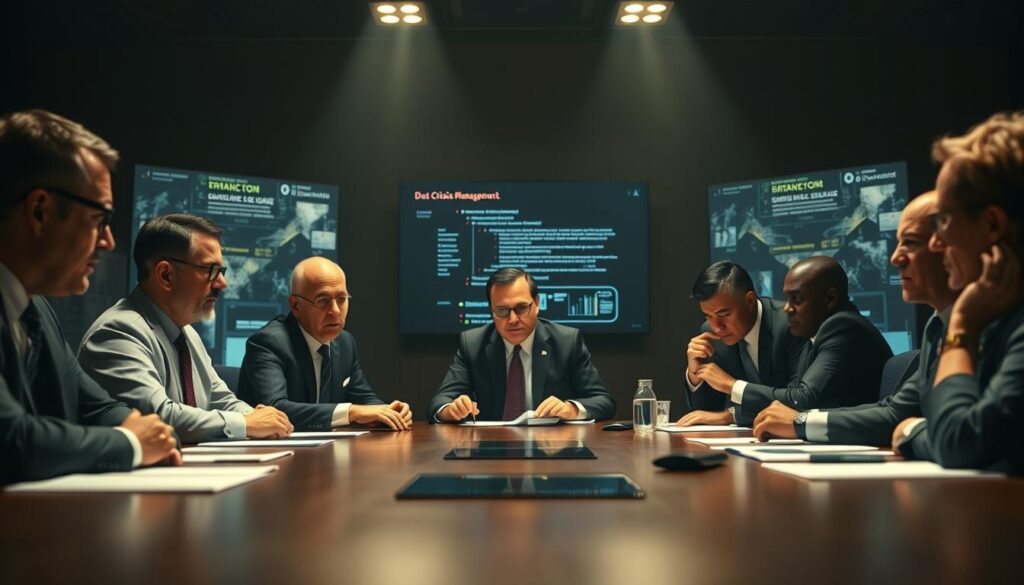As Warren Buffett once said, “It takes 20 years to build a reputation and five minutes to ruin it.” In today’s fast-paced digital world, this statement rings truer than ever. The rise of social media has transformed how crises unfold, with information spreading faster than ever before. Brands like United Airlines and Pepsi have faced significant backlash due to mishandled responses, proving that a single misstep can damage years of hard-earned trust1.
Traditional crisis management methods often struggle to keep up with the speed of modern communication. Delayed responses or tone-deaf messaging can escalate issues, leaving brands vulnerable. This is where technology steps in, offering tools to monitor, analyze, and respond to crises with greater efficiency2.
However, speed alone isn’t enough. Maintaining authenticity and empathy remains crucial. Balancing these elements is key to protecting a brand’s reputation and rebuilding customer trust. This article explores how modern solutions are reshaping crisis response, offering actionable insights for PR professionals.
Key Takeaways
- Social media accelerates the spread of crises, demanding faster responses.
- Brands like United Airlines and Pepsi highlight the importance of effective communication.
- Technology enhances efficiency in monitoring and responding to crises.
- Authenticity and empathy are critical in maintaining trust.
- Modern tools can help PR professionals protect brand reputation.
Introduction to AI in Crisis Management

The digital era has reshaped how brands respond to unexpected challenges. With the rise of social media, crises now unfold at lightning speed, leaving little room for error. Traditional methods often fall short in this fast-paced environment, making innovation essential.
Modern technology plays a pivotal role in addressing these challenges. By analyzing data from countless sources simultaneously, it enhances real-time decision-making during crises3. This capability is crucial for brands aiming to stay ahead of potential issues.
The Changing Landscape of PR Crises
Social media has accelerated the onset of PR crises, turning minor incidents into global headlines in minutes. For example, high-profile cases like United Airlines and Pepsi demonstrate how a single misstep can escalate quickly. These situations highlight the need for proactive approaches and timely detection of crisis signals.
The increasing complexity of crisis management is driven by rapid news dissemination across various media platforms. PR teams now face the challenge of maintaining clear communication while navigating this dynamic landscape. Tools that monitor and analyze data in real-time are becoming indispensable3.
During the recent global pandemic, technology was used for contact tracing and managing guest flows, showcasing its effectiveness in public health emergencies3. This example underscores the importance of integrating innovative solutions into crisis strategies.
As the landscape evolves, the need for authenticity and empathy remains critical. Balancing efficiency with human connection is key to protecting a brand’s reputation. This section sets the foundation for understanding the evolving nature of crises and the necessity for innovative approaches.
Utilizing AI Prompts for Crisis Management Communication

In today’s fast-moving digital landscape, staying ahead of potential crises is more critical than ever. With the speed at which information spreads, brands must adopt innovative strategies to detect and address issues before they escalate. Advanced tools now play a pivotal role in this process, offering real-time insights and actionable solutions.
Early Detection and Real-Time Monitoring
One of the most significant advantages of modern technology is its ability to identify emerging crises early. By monitoring social media, news outlets, and online forums, organizations can detect negative trends before they gain traction. For example, sentiment analysis tools analyze public opinion, providing alerts when negative sentiment spikes4.
Real-time monitoring ensures that brands stay informed about potential threats. This approach allows teams to act swiftly, minimizing the impact of a crisis. Companies like Uber and KLM Royal Dutch Airlines have successfully used these tools to address issues promptly5.
Automated Response Generation and Analysis
When a crisis hits, time is of the essence. Automated systems can draft initial responses using natural language processing (NLP), ensuring timely communication. These systems analyze historical data to predict potential scenarios, helping teams prepare effective strategies4.
Consistency in messaging is crucial during a crisis. Automated tools ensure that responses align with the brand’s tone and values, reducing the risk of miscommunication. Additionally, these tools provide insights into customer sentiment, enabling teams to refine their approach5.
By integrating social listening tools, organizations can gather valuable feedback and adjust their strategies accordingly. This proactive approach not only mitigates risks but also strengthens customer trust4.
Implementing AI Tools: Practical Guidance

Starting small can lead to big improvements in crisis readiness. Begin with basic monitoring tools to track online sentiment and identify potential issues early. This approach allows teams to test capabilities without overwhelming resources6.
Social listening initiatives are a practical way to evaluate these tools. By analyzing public conversations, brands can gain valuable insights into customer sentiment and emerging risks7. This data helps refine strategies and ensures timely responses.
Building Team Capability and Protocols
Training is essential for effective crisis handling. Develop role-specific modules to ensure every team member understands their responsibilities. Simulations and workshops can prepare teams for real-world scenarios6.
Establish clear protocols for tool usage and communication. This ensures consistency and reduces the risk of missteps during a crisis. Regularly review and update these protocols based on performance metrics and lessons learned7.
Integrating tools into existing processes should be gradual. Start with pilot programs to test effectiveness before scaling up. This approach minimizes disruption and allows for adjustments based on feedback6.
Balancing procedural rigor with flexibility is key. While protocols provide structure, teams must adapt to unforeseen situations. This balance strengthens a brand’s ability to handle crises with authenticity and trust7.
Enhancing Stakeholder Communication with AI
Effective communication during a crisis hinges on understanding and addressing stakeholder needs. Personalized engagement ensures that messages resonate with specific audiences, fostering trust and credibility. Modern tools enable brands to segment their audience and craft tailored responses that address unique concerns8.
Personalized Engagement Strategies
Audience segmentation is a key strategy in crisis communication. By dividing stakeholders into groups based on demographics, behavior, or preferences, brands can deliver targeted messages. For example, KLM Royal Dutch Airlines uses AI-driven chatbots to provide personalized responses to customers during flight disruptions8.
Tailoring messages to different platforms also enhances engagement. Social media, email, and chatbots each require a unique approach. The BBC uses AI tools to adapt news items and responses to align with public sentiment during crises8.
Real-time data analysis allows companies to refine their messaging as situations evolve. Predictive analytics help anticipate stakeholder reactions, enabling proactive adjustments9. This ensures that communication remains relevant and impactful.
Personalized strategies not only maintain consumer trust but also bolster brand credibility. By addressing individual concerns, companies demonstrate empathy and understanding. This approach strengthens relationships and minimizes the negative impact of a crisis8.
In summary, leveraging modern tools for audience segmentation and tailored messaging enhances stakeholder communication. Companies that prioritize personalization can navigate crises more effectively, ensuring long-term trust and loyalty.
Balancing AI Efficiency with Human Empathy
The balance between rapid response and genuine care defines modern crisis handling. While technology offers speed, it cannot replicate the depth of human emotion. This is why blending efficiency with empathy is critical in navigating challenging situations10.
Ethical Considerations and Limitations
Transparency is essential when using advanced tools in crisis situations. Customers value honesty, and 80% are more likely to trust brands that demonstrate genuine concern10. Ethical use of technology ensures that responses align with brand values and avoid missteps.
However, tools have limitations. They lack the nuance and critical judgment that humans bring to decision-making. For example, poorly worded or tone-deaf communications can damage a brand’s reputation, as seen in 60% of consumer feedback10.
Human oversight is crucial to prevent automated errors. In high-severity crises, such as disasters or cyberattacks, human-led communication supported by analytical tools ensures clarity and trust11.
Best practices include clear guidelines and decision-making frameworks. These ensure that technology complements the instincts and expertise of professionals. By maintaining this balance, brands can navigate crises with authenticity and trust10.
Conclusion
Modern strategies in handling unexpected challenges emphasize a balanced approach. Early detection, practical implementation, and personalized engagement are key to strengthening PR efforts. By integrating advanced tools, teams can analyze data and respond swiftly to emerging risks12.
Automated systems enhance efficiency, but human empathy remains irreplaceable. Combining these elements ensures authenticity and trust, which are critical in maintaining brand reputation. For example, companies like KLM Royal Dutch Airlines have successfully blended technology with human oversight to manage disruptions effectively12.
PR professionals should adopt a step-by-step roadmap to integrate these tools. Start with basic monitoring and gradually scale up, ensuring ethical considerations and data security are prioritized. This approach minimizes risks while enhancing decision-making13.
Building a resilient system requires continuous learning and adaptation. Tools like ChatGPT can streamline tasks, but human judgment ensures accuracy and appropriateness. Stay proactive, review strategies regularly, and focus on fostering trust with stakeholders.
FAQ
How can AI help in early detection of a crisis?
What are the benefits of automated response generation?
How can companies start using AI for crisis management?
Can AI enhance stakeholder communication during a crisis?
What are the ethical limitations of using AI in crisis management?
How does AI improve decision-making during a crisis?
What role does social listening play in crisis management?
How can businesses balance AI and human empathy in communication?
Source Links
- 10 Helpful ChatGPT Prompts for Crisis Management Strategies | Bizway
- Generative AI is set to transform crisis management
- Hotel Crisis Management: AI in Emergency Response Planning
- Prompts For Crisis Management Scenarios: Enhance Your Response – PromptsTY
- AI for Crisis Communications: The Ultimate Toolkit
- How to create an effective AI strategy in 2024
- AI Guidance
- “AI-Driven Crisis Management: Staying Ahead of PR Challenges”
- Best AI Prompts for Crisis Communication Plan
- The Importance of Empathy in Crisis Response | Sprinklr
- When should we use AI in crisis communications?
- Futurium | European AI Alliance – AI for Crisis Management: Impacts, Challenges, Best Practices
- Face the Digital Age of AI in PR and Avoid Pitfalls: Five Ways to Prepare







